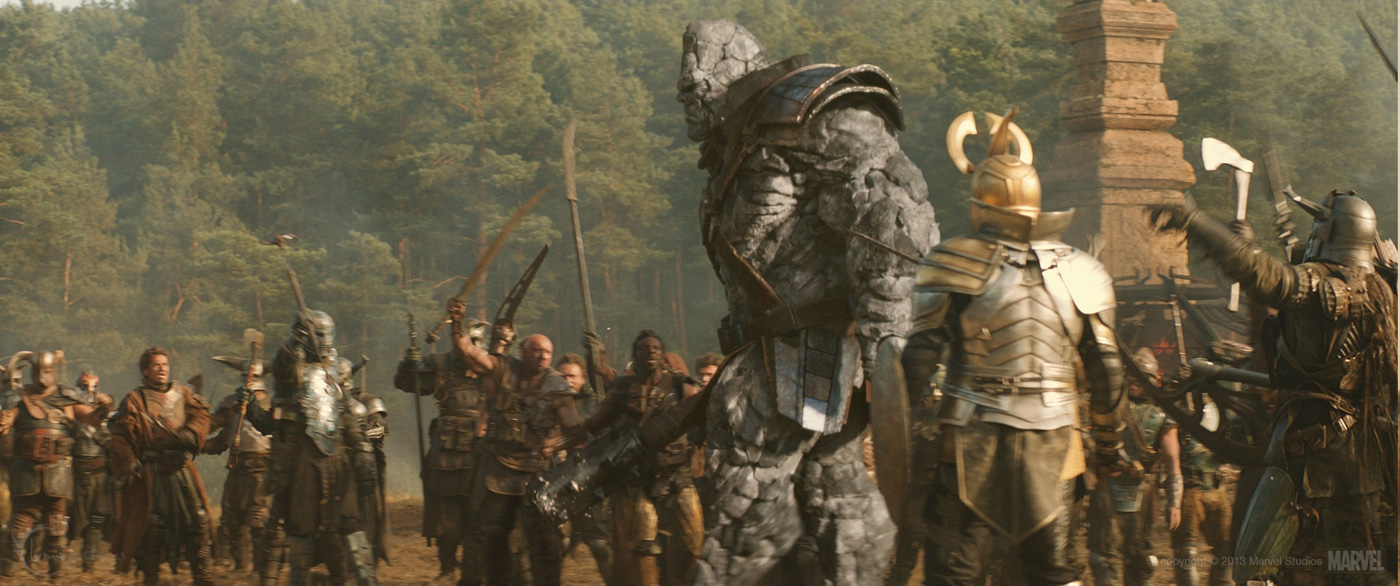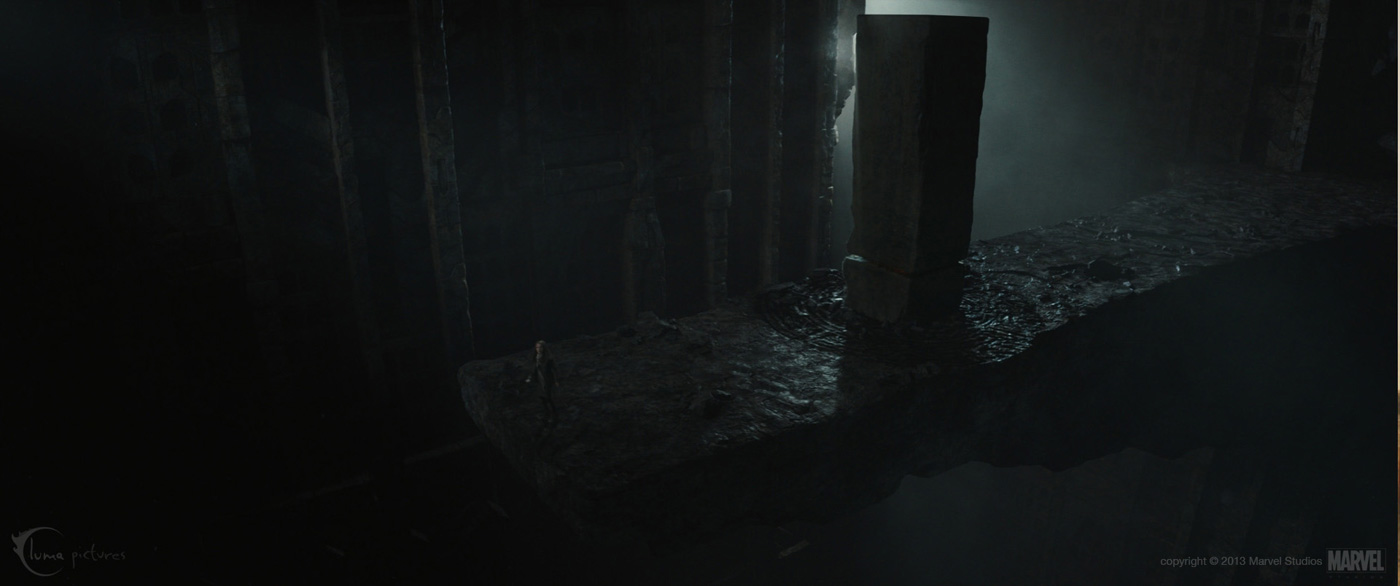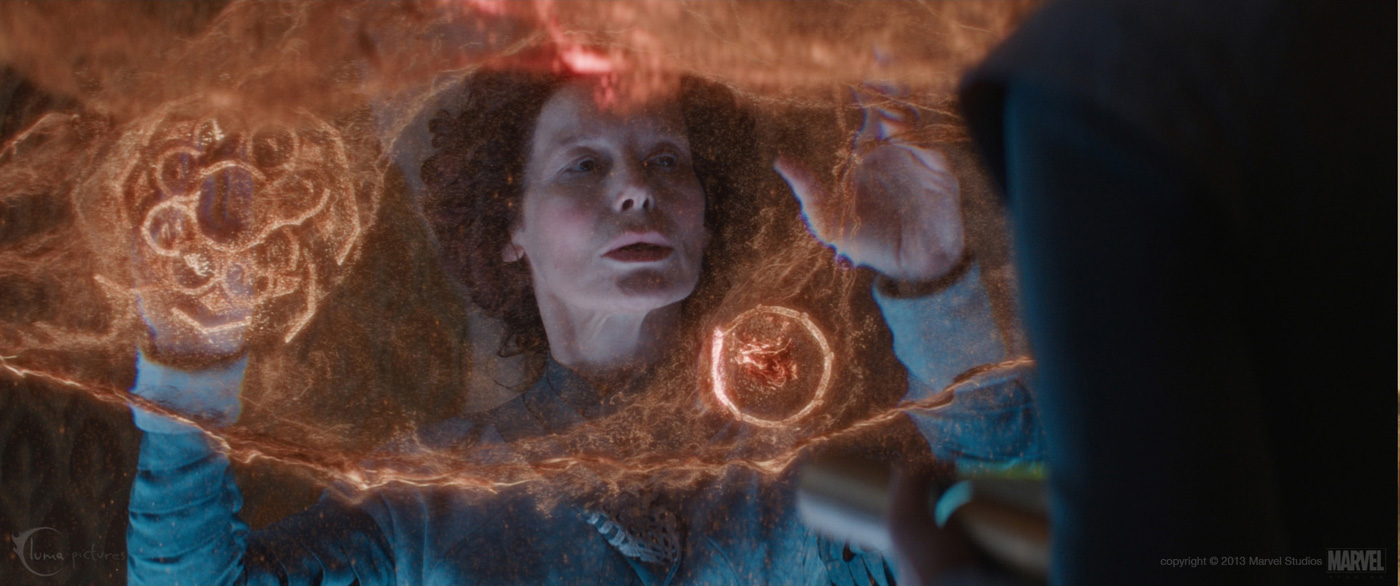Since his last appearance on The Art of VFX for PROMETHEUS, Vincent Cirelli has worked on many films such as OZ THE GREAT AND POWERFUL, GI JOE: RETALIATION, IRON MAN 3 or PRISONERS.
What was your feeling to be back in Thor universe?
We were excited to be able to explore Asgard a bit deeper, adding some new characters and sets as well as adding more depth to some of the old ones.
How was the collaboration with director Alan Taylor?
For this film, we collaborated mostly with Jake Morrison and the Marvel creative team.
How was the collaboration with Production VFX Supervisor Jake Morrison?
Jake is a futurist at heart, with a boundless imagination, and very technically adept. His visions for the project were backed up by a strong technical understanding of how to make them happen. The whole process with him was very collaborative and fun, with a lot of room for us to test out ideas and concepts
What have you done on this show?
For this show, we created the Stone Man, Frost Beast, The Aether within Natalie Portman, Ygdrissil, the Healing Chamber fx, Hymdaal’s observatory interior, The Aether Chamber environment, The Gyroscope Room and fx, Sections of the interior Palace of Asgard, the medical holograms in the Healing Chamber, Ice cave on Jotenheim, fighter jets, Portals, Bi Frost Effects Asgard Force Field Generator.
How did you approach the creation of the various creatures?
We always start in 2D, refining the concept of the creatures, starting with whatever production art is provided, adding details to allow us more options to create the performance and bring it to life on screen.
Can you explain in details about their creation?
The biggest challenge in the creation of the ‘Stone Man’ was building a character made of many smaller rigid elements that had to move together without bending and without creating unsightly gaps, or penetrations.
How did you manage the rigging and animation?
As you can see the ‘Stone Man’ is made of hundreds of individual rocks. To allow for the ‘Stone Man’ to move while allowing the rocks that comprised him to maintain volume and slide over each other, we started with our proprietary rigging simulation technology we had developed for ‘The Destroyer’ in the first THOR film (a metal suit with dozens of layered metal slats). For the ‘Stone Man’, we upgraded the system to allow for a large number of irregular shaped pieces of rocks to slide over each other without intersecting.
The face, comprised of many smaller discrete pieces, was especially tricky. In order to create depth in the facial expressions, the facial rig uses underlying mesh representing a mantle that helps control the smaller discrete rocks. This allows the rocks on the surface to be easily manipulated and art directable to deliver the best performance possible.
The Frost Beast was a lot of fun as well. For this creature, Loic Zimmerman our concept artist worked with the concept from the first film, adding a more features and defining more of bone structure for this smaller, but just as menacing next of adolescent version.
We looked at various reference of elephants and other large animals, running and fighting, to get inspiration for the animation. Our muscle simulation techniques went to good use on this character, defining the tendons, and muscle group flexing as he comes running into the scene!
How did you create the digi-doubles of Thor and the Dark Elves?
We have a motion capture stage at Luma. Our Animation Supervisor’s captured a mock performance and targeted into the our Rig, The original DNeg model was bound to the motion capture rig and rendered in Arnold.
The BiFrost is back in this new episode. Can you tell us more about it?
The Bifrost emanates from the technology in the Observatory in the film which was one of our full CG sets. For many of the shots, the Bifrost itself was created using cylindrical geometry and multiple 2.5D cards and inside Nuke, with 3D renderings in Maya and FumeFX being used for the external shots.
Can you explain in details about the creation of the huge environment where Natalie Portman discover the Aether?
The name of this environment is the Crypt. It is a cavernous environment which we created in a modular way, by building it in sections like chunks of lego bricks. This way, we could move pieces around, duplicate them, and position the walls in an aesthetic way throughout the whole sequence. Once we had the layout approved, we went in and set dressed the entire chamber to give each area individual variation. All this was rendered in Arnold.
Can you explain about the Healing Chamber and the hologram?
Jake had discussed wanting to explore the use of nanotechnology for the ‘Soul Forge’. The idea was that the ‘Soul Forge’ scans Jane’s soul, detects the aether, and displays it in a 3D volume of Jane’s body, created by the nano tech. The nanobots stream from tuning forks on either side of the table as if caught in a magnetic field. We ran with this idea, creating a swarming particle system which could coalesce into any form volume. In order to get this very unique look, our FX TD John Cassella wrote a plugin called ‘Creep Field’ which allows the particles to hop and skip around each other at a very fine granular level.
You have created various CG sets. What was your approach about them?
Yes, we created a few CG sets for this film, including the observatory interior, an underground section of the Asgard Palace, the Chamber. Each one had a unique approach.
Which environment was the most complicated to create and why?
The observatory interior was probably the most complicated to create because the entire building interior needed to be rigged in such a way that would allow for the entire building to rotate down, while smaller components inside turned like clockwork.
Can you tell us more about the Fighter Jets and their missiles?
We modeled out the fighter jets to hold up at a very close distance. The camera on a couple shots are parked right under the wing. We researched the type of missiles (typhoon) these fighter jets would have while creating the models. Everything was modeled in Maya, then painted in Mari. Arnold shader development was done by one of our CG Sups, Pavel Pranevsky. Everything was rendered in Arnold including the fluids for the contrails and thrusters from the missiles.
How did you create the Portal effects?
Portal effects were created with cloth, and fluid simulation for some shots, and depending on the size of the portal, we used simpler techniques utilizing geometry and Nuke.
What was the biggest challenge on this project and how did you achieve it?
The Aether was the biggest challenge the show. It was a very important aspect of the film and underwent the most time in development to achieve a look that was right. Unlike other viscous liquids we’ve created in the past, the aether had to have a very surreal movement. To achieve this, our FX TD John Cassella coded a custom particle system in Maya creating the strange tendrils which weave upon themselves, and then meshed the results in Houdini. It was a fun design challenge!
Was there a shot or a sequence that prevented you from sleep?
You never know which shots are going to really challenge you so we always find a way to convert the pressure into passion, to inspire the artists, even when ideas evolve. Because we care so much about what we do, there will always be a few sleepless nights along the way.
What do you keep from this experience?
I’ll miss our hilarious cineSyncs with Jake, Di and team. They’re really a great group and a lot of fun to work with.
How long have you worked on this film?
Around 6 months for shot execution, and worked on concept and tech dev prior to that.
How many shots have you done?
Just under 300.
A big thanks for your time.
// WANT TO KNOW MORE?
– Luma Pictures: Official website of Luma Pictures.
© Vincent Frei – The Art of VFX – 2014










They can never say… We’ll actually we scanned them to create the digital doubles. We also got the colour from photographing them & the movement… we’ll we got that from them as we’ll. it’s just not impressive. Sorry, the computers do so much of the work now. I know… I do this for a living on big movies.